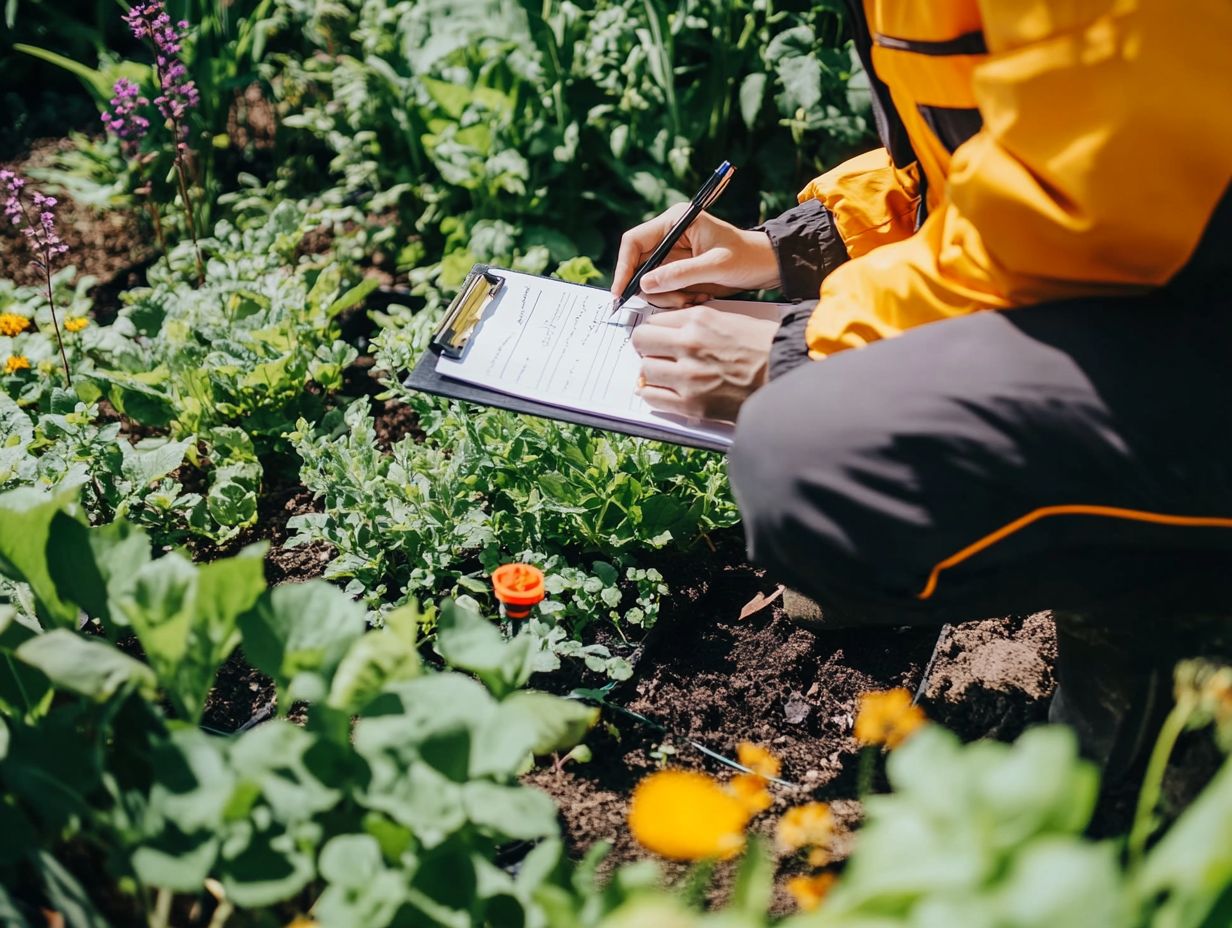How to Create a Pest Monitoring Plan
Pest monitoring is pivotal in the realm of effective pest control, enabling you to detect infestations early and manage them with precision!
This guide will show you how to create an effective pest monitoring plan, beginning with the identification of target pests and the selection of the most effective monitoring methods.
Delve into a variety of techniques, from traps and baits to careful visual checks, and discover how to implement and assess your plan for optimal outcomes.
Get ready to tackle pests effectively!
Contents
- Key Takeaways:
- The Importance of Pest Monitoring
- Steps to Creating a Pest Monitoring Plan
- Effective Pest Monitoring Techniques
- Implementing and Evaluating the Plan
- Frequently Asked Questions
- What is a pest monitoring plan and why is it important?
- How do I create a pest monitoring plan?
- What factors should I consider when creating a pest monitoring plan?
- Do I need to involve a professional pest control company to create a pest monitoring plan?
- How often should a pest monitoring plan be implemented?
- What should I do if I detect pests during the monitoring process?
Key Takeaways:

The Importance of Pest Monitoring
Pest monitoring stands as an essential pillar of effective pest management, offering valuable insights that enable you to identify pests and assess their activity.
By accurately tracking pest populations, you can uphold food safety, adhere to stringent sanitation practices, and address potential pest issues proactively, preventing them from spiraling into serious infestations.
This systematic approach gives power to pest control professionals to craft a management plan tailored specifically to your environment, ensuring both immediate and lasting relief from structural pests like rodents and insects.
Why Monitoring is Essential for Pest Control
Monitoring is absolutely essential for pest control, as it allows you to identify pest populations before they hit those critical action thresholds.
If you overlook this vital step, you risk allowing pest populations to flourish unchecked, which can threaten both your health and property.
Regular inspections are key! Without them, the chances of encountering widespread damage increase, making it increasingly difficult to manage the situation once it spirals out of control.
Effective pest management isn t just about reacting to problems it s also about being proactive.
Creating a comprehensive pest management checklist can be invaluable in guiding your evaluations.
This checklist will help you spot common signs of pests and ensure that preventive measures are consistently implemented, ultimately protecting your space and drastically reducing long-term pest risks!
Steps to Creating a Pest Monitoring Plan
Developing a comprehensive pest monitoring plan requires several important steps that enable you to effectively identify pests and establish an action threshold for necessary interventions.
This structured approach begins with pinpointing your target pests and assessing their activity levels through a range of monitoring techniques.
Next, it s vital to meticulously document your findings and employ pest control tactics to craft effective responses.
By implementing such a plan, you’ll not only manage pest populations proactively but also elevate your overall pest control strategies to suit specific environments seamlessly.
Identifying Target Pests
Properly identifying your target pests is the cornerstone of effective pest monitoring and management.
Different pests whether rodents, insects, or birds have unique traits that are crucial to understand.
This knowledge gives you the power to tailor your pest control approach specifically to your situation.
You can employ various methods to accurately identify these nuisances.
Start with thorough visual inspections of your premises, looking for signs such as droppings, nests, or damage, which can clue you in on specific types of infestations.
Consulting with reputable pest control companies is also a wise move; they can offer expert insights and guidance to help you achieve accurate identification and develop effective strategies.
As you delve deeper into the biology of these pests, you ll find that understanding their habits and life cycles can significantly enhance your monitoring techniques.
This knowledge makes it easier to devise targeted treatment plans that are not only efficient but also environmentally responsible.
Determining Monitoring Methods

Determining the right monitoring methods is essential for effectively assessing pest activity. You’ll want to select traps and monitoring devices specifically tailored to the pests you encounter.
By utilizing a combination of various monitoring techniques, you can significantly enhance your pest control efforts. For example, regular inspections using visual checks, pheromone traps, and camera systems will give you a comprehensive overview of pest populations. Using the latest technology, such as IoT-enabled traps that send real-time data about pest activity to your devices, allows you to make timely adjustments to your pest management strategies.
Maintaining a consistent inspection schedule typically weekly to bi-weekly ensures that even the faintest signs of activity are spotted before they escalate into larger problems. Understanding these signs is crucial, as it enables you to refine your pest control measures and adopt a proactive approach to managing infestations.
Setting Action Thresholds
Setting action thresholds is crucial in your pest monitoring efforts, allowing you to determine the ideal moment to implement control methods based on pest population levels.
By analyzing specific monitoring data and gaining insights into the biology of your target pests, you can establish quantifiable thresholds that clearly indicate when intervention is necessary. Understanding the life cycle and behavior of these pests enables you to make more accurate predictions about their population dynamics. This knowledge informs not only the timing of your actions but also the selection of appropriate control measures.
Incorporating these thresholds into a comprehensive pest management plan is essential. This approach ensures that your preventive measures are both timely and effective, reducing the need for more drastic interventions down the line and fostering sustainable pest management practices.
Creating a Monitoring Schedule
A solid monitoring schedule is your secret weapon in pest management! It is vital for maintaining consistency in your pest management efforts, ensuring that inspections are conducted promptly and according to established frequencies, often including pest control inspections that assess signs of pest activity.
This proactive approach makes it essential to assess environmental factors like seasonal changes and local climates that can influence pest behavior.
By taking these variables into account, you can adjust your schedule to meet specific needs, resulting in a tailored strategy. Incorporating a comprehensive pest management checklist not only helps you systematically document inspections but also assists in tracking findings over time.
Such meticulous record-keeping enhances your ability to identify trends and make informed decisions about necessary interventions. Act quickly to identify these signs before they escalate, ultimately leading to more effective pest control strategies.
Effective Pest Monitoring Techniques
Effective pest monitoring techniques are crucial for accurately assessing pest activity and making informed decisions regarding pest control strategies. These techniques encompass the use of traps and baits, comprehensive visual inspections, and advanced monitoring devices that enable real-time data collection and analysis.
By implementing these methods, you position yourself to tackle pest issues with precision and confidence. Stay ahead of pests by adopting these effective monitoring techniques today!
Traps and Baits
Traps and baits are essential monitoring techniques that help you identify pest populations and function as effective pest control methods when paired with preventative strategies.
These tools come in various forms, such as sticky traps for pesky flies, snap traps for rodents, and bait stations specifically designed for termites or ants. Each type offers unique effectiveness based on the target pest, allowing you to customize your pest management approach to suit your needs, whether you re a homeowner or a professional.
By strategically placing these traps, you can better monitor activity levels and pinpoint pest hotspots. Integrating traps and baits into a comprehensive pest management system significantly enhances overall effectiveness. The data collected from these tools can inform your future control actions while providing valuable insights into pest behavior and identification.
Visual Inspections

Visual inspections play a crucial role in pest monitoring. They enable you to detect signs of pest activity and evaluate the effectiveness of your monitoring methods.
As you systematically examine various areas for indicators such as droppings, nesting materials, or gnaw marks, these inspections provide vital insights into the presence and magnitude of infestations. Conducting these assessments regularly ideally every few weeks ensures that any emerging issues are addressed promptly, preventing them from escalating into larger problems.
Thorough visual checks empower you to develop targeted pest control strategies. This allows you to tailor your interventions based on the specific types of pests you identify. Acting quickly with this approach can save you from bigger problems down the road!
Monitoring Devices
Modern monitoring devices have truly transformed pest management. They provide you with real-time data on pest activity that significantly enhances the effectiveness of your pest management plans.
These advanced tools range from networked traps equipped with sensors to mobile applications that track pest movements. They grant you a level of precision and insight that was once thought impossible.
These devices utilize computer programs that can learn and make decisions, helping to identify pest species and anticipate potential outbreaks by analyzing environmental conditions. By incorporating these sophisticated monitoring systems into your strategies, you can tailor your methods and interventions with greater efficiency.
This approach leads to substantial improvements in pest activity assessments, ultimately fostering more sustainable pest management practices.
Implementing and Evaluating the Plan
Implementing and evaluating your pest monitoring plan is essential for ensuring its effectiveness. By regularly assessing the plan, you can adapt your strategies to respond effectively to ever-changing pest populations.
This proactive approach safeguards your environment and enhances your overall pest management efforts.
Putting the Plan into Action
Implementing your pest monitoring plan involves putting into action the established techniques and pest control strategies detailed in your management plan.
To kickstart this process effectively, it’s essential to provide thorough training for your team. This ensures they have the skills to accurately identify pest activity. The training should highlight the importance of sticking to scheduled inspections, enabling timely and consistent evaluations of the pest situation.
Regularly reviewing your monitoring techniques boosts the effectiveness of inspections and fosters a proactive mindset. By employing these methods, your team can swiftly detect early signs of infestations, allowing for rapid interventions that greatly minimize the likelihood of widespread pest problems.
Ultimately, this strategic emphasis on training and adherence to protocols creates an environment where effective pest control measures can truly thrive.
Assessing the Effectiveness of the Plan
Assessing the effectiveness of your pest monitoring plan is crucial for understanding whether your pest management strategies are delivering the results you desire.
Regular evaluations, grounded in clear criteria like pest population thresholds and damage assessments, offer valuable insights into how well these strategies operate in real-world scenarios. Proper documentation is key in this process, allowing you to systematically collect data that can be analyzed over time.
By reviewing trends and anomalies in the data, you can make informed decisions that elevate your current monitoring practices. The lessons learned from these assessments can profoundly influence your future interventions, paving the way for a more adaptive and effective approach to pest management.
Frequently Asked Questions

Start implementing your pest monitoring plan today for a healthier environment!
What is a pest monitoring plan and why is it important?
A pest monitoring plan is a proactive strategy for identifying and controlling pests in a specific area.
It’s crucial because it helps prevent pest infestations and the spread of diseases carried by pests. Take action now!
How do I create a pest monitoring plan?
The first step is to identify the types of pests common in your area that could cause problems.
Next, assess the risk level for each pest and determine appropriate ways to check for pests, such as traps or visual inspections. Take action now!
What factors should I consider when creating a pest monitoring plan?
When creating a monitoring plan, consider factors like the type of property being monitored and the surrounding environment.
Also, think about the types of pests that could cause harm or damage. Take action now!
Do I need to involve a professional pest control company to create a pest monitoring plan?
Consulting a pest control professional is wise, but you can create a monitoring plan on your own.
For more complex or high-risk situations, it’s best to seek the help of a professional. Take action now!
How often should a pest monitoring plan be implemented?
The frequency of your monitoring plan depends on risk levels and the types of pests being monitored.
In general, conduct monitoring at least once a month, but more frequent checks may be necessary in high-risk areas. Take action now!
What should I do if I detect pests during the monitoring process?
If you detect pests during the monitoring process, take immediate action to control and eliminate them.
This may involve implementing pest control measures or seeking help from a professional pest control company. Take action now!






